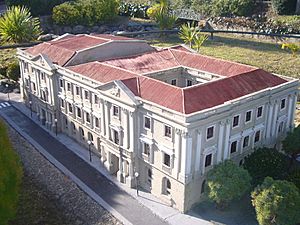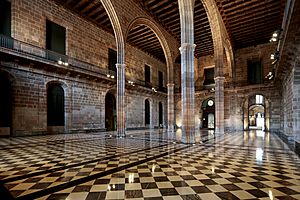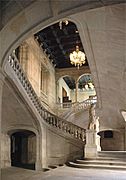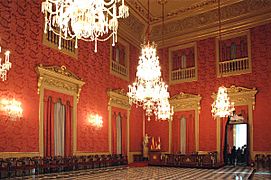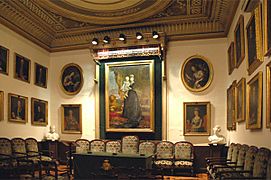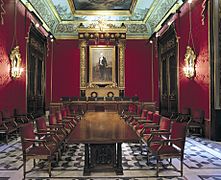Llotja de Barcelona facts for kids
Quick facts for kids Llotja de Barcelona |
|
|---|---|
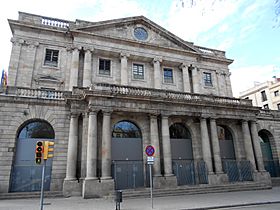
Palace of the Llotja de Mar
|
|
| General information | |
| Status | Monument |
| Type | Bien de Interés Cultural Patrimonio histórico español |
| Architectural style | Gothic and Neoclassical |
| Location | Sant Pere, Santa Caterina i la Ribera |
| Address | Passeig d'Isabel II, 1 |
| Town or city | |
| Country | |
| Coordinates | 41°22′56″N 2°10′57″E / 41.3822°N 2.1825°E |
| Construction started | 14th-15th Centuries |
| Construction stopped | 1774-1802 |
| Owner | Cambra Oficial de Comerç, Indústria i Navegació de Barcelona |
| Design and construction | |
| Architect | Pere Arvei and Joan Soler i Faneca |
| Known for | Cambra de Comerç de Barcelona, Reial Acadèmia Catalana de Belles Arts de Sant Jordi |
The Llotja de Barcelona or Llotja de Mar is a famous building in Barcelona, Spain. Its name means "Loggia of Barcelona" or "Sea Loggia" in Catalan. It's located near the sea in the La Ribera neighborhood.
Today, the building looks Neoclassical, a style popular in the 18th century. But inside, it hides a much older part: a beautiful Gothic hall from the Middle Ages called the saló de Contractacions (Contracting Hall).
This building was first made for merchants to do business. Over time, it was used for many things, like storing wheat, hosting shows, and even as a military barracks. Now, it's home to the Cambra de Comerç (Chamber of Commerce) and the Reial Acadèmia Catalana de Belles Arts de Sant Jordi (Royal Catalan Academy of Fine Arts of Sant Jordi).
Contents
A Look at History
As trade grew in Barcelona, merchants needed a special place to meet. So, between 1352 and 1357, a porch was built by Pere Llobet near the port. This area was already a busy spot for trade.
Soon, this porch became too small. Around 1380, King Peter IV of Aragon allowed a much larger, enclosed hall to be built. This hall would protect merchants from bad weather and the sea. Pere Arvei was the architect for this big project, which took place from 1384 to 1397. Even after the main hall was finished, more parts were added later, like a courtyard and a small chapel. An upper floor was also built to house the Consulate of the Sea, an important group that handled maritime trade rules.
Over the years, the Gothic building changed its purpose many times. It was used to store wheat, as a place for performances, and even as a weapons storage. After a big battle in 1714, it became a military barracks.
One interesting event was the first Italian opera ever performed in Spain! It happened here on August 2, 1708. The opera was called Il più bel nome by Antonio Caldara. It was performed for the wedding of Archduke Charles of Austria.
In 1767, the building was given to the Royal Barcelona Board of Trade. This group decided to rebuild it in the popular Neoclassical style.
The Board of Trade also started many schools to help with trade and industry. One of these was the Free School of Design, which opened in 1775. This school later became the School of Arts and Crafts of Barcelona and the Reial Acadèmia Catalana de Belles Arts de Sant Jordi. The Academy still uses the upper part of the building to display its amazing art collection, even though the school itself moved to a different location.
From 1915 until 1994, the Barcelona Stock Exchange operated in the old Contracting Hall.
Today, the building is still very important. It serves as the main office for the Cambra de Comerç (Chamber of Commerce) and the Reial Acadèmia Catalana de Belles Arts de Sant Jordi.
The Neoclassical Building Today
This building is a fantastic example of neoclassicism in Barcelona. When you see it, you'll notice its impressive facades, the beautiful courtyard, and the grand staircase. The courtyard and staircase are decorated with many sculptures.
For example, there's a Fountain of Neptune by Nicolau Travé, with two mermaid-like figures called nereids by Antoni Solà. In the corners of the courtyard, there are four statues representing the continents: Europe and Asia by Josep Bover, and Africa and America by Manuel Olivé. At the bottom of the staircase, you'll find two statues showing Commerce and Industry by Salvador Gurri.
Some rooms on the main floor still have their original 18th-century decorations and display many artworks. In the Salón Dorado (Golden Hall), you can see the famous sculpture Lucrecia by Damià Campeny, which is a major work of Neoclassical art in Europe.
The Neoclassical part of the building was constructed between 1774 and 1802. It was designed by Joan Soler i Faneca and later by his son, Tomàs Soler i Ferrer, and Joan Fàbregas. The building is 22 meters tall, and its facades have four triangular tops called pediments. Its important location, facing the old Palace of the Viceroy and the sea, shows how significant it was.
The Hidden Gothic Building
The original Gothic Llotja de Barcelona is considered one of the first great examples of buildings made for trade in the Crown of Aragon. It was probably inspired by similar buildings in Italy and the Netherlands, showing the growing power of merchants in Barcelona.
The most important part of that old building still exists today, completely surrounded by the newer Neoclassical structure. This includes the Contracting Hall (Catalan: saló de Contractacions) and the Consuls Hall (Catalan: saló dels Cònsols) above it.
The Contracting Hall is 14 meters high. It has three long sections separated by arches supported by four columns. These arches hold up the wooden ceiling and the floor above. Look closely at the arches, and you'll see the coats of arms of the king and the city. This shows that both the king Peter IV of Aragon and the city council (the Consell de Cent) helped build it.
Between 2000 and 2001, experts found the original 14th-century stone floor of the lower hall during archaeological digs.
Image gallery
See also
 In Spanish: Lonja de Barcelona para niños
In Spanish: Lonja de Barcelona para niños


